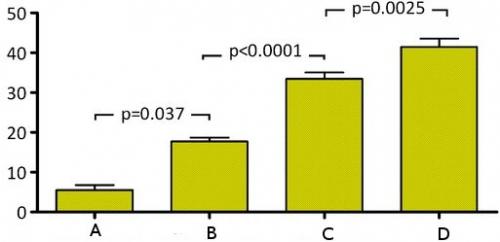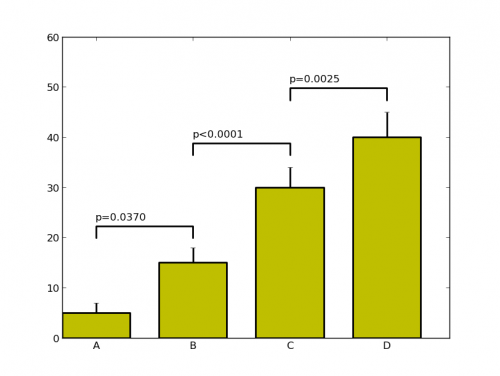Wskazanie statystycznie istotnej różnicy w wykresie słupkowym
Używam wykresu słupkowego, aby wskazać dane każdej grupy. Niektóre z tych barów znacznie różnią się od siebie. Jak mogę wskazać znaczącą różnicę na wykresie słupkowym?
import numpy as np
import matplotlib.pyplot as plt
menMeans = (5, 15, 30, 40)
menStd = (2, 3, 4, 5)
ind = np.arange(4) # the x locations for the groups
width=0.35
p1 = plt.bar(ind, menMeans, width=width, color='r', yerr=menStd)
plt.xticks(ind+width/2., ('A', 'B', 'C', 'D') )
Celuję

2 answers
Zrobiłem tu kilka rzeczy, które sugeruję przy pracy z skomplikowanymi fabułami. Wyciągnij niestandardowe formatowanie do słownika, to ułatwia życie, gdy chcesz zmienić parametr - i możesz przekazać ten słownik do wielu wykresów. Napisałem również niestandardową funkcję do annotate wartości ITER, jako bonus może dodawać adnotacje między (A,C), jeśli naprawdę chcesz (podtrzymuję mój komentarz, że nie jest to właściwe podejście wizualne). Może wymagać pewnych poprawek po zmianie danych ale to powinno cię skierować na właściwą drogę.
import numpy as np
import matplotlib.pyplot as plt
menMeans = (5, 15, 30, 40)
menStd = (2, 3, 4, 5)
ind = np.arange(4) # the x locations for the groups
width= 0.7
labels = ('A', 'B', 'C', 'D')
# Pull the formatting out here
bar_kwargs = {'width':width,'color':'y','linewidth':2,'zorder':5}
err_kwargs = {'zorder':0,'fmt':None,'linewidth':2,'ecolor':'k'} #for matplotlib >= v1.4 use 'fmt':'none' instead
fig, ax = plt.subplots()
ax.p1 = plt.bar(ind, menMeans, **bar_kwargs)
ax.errs = plt.errorbar(ind, menMeans, yerr=menStd, **err_kwargs)
# Custom function to draw the diff bars
def label_diff(i,j,text,X,Y):
x = (X[i]+X[j])/2
y = 1.1*max(Y[i], Y[j])
dx = abs(X[i]-X[j])
props = {'connectionstyle':'bar','arrowstyle':'-',\
'shrinkA':20,'shrinkB':20,'linewidth':2}
ax.annotate(text, xy=(X[i],y+7), zorder=10)
ax.annotate('', xy=(X[i],y), xytext=(X[j],y), arrowprops=props)
# Call the function
label_diff(0,1,'p=0.0370',ind,menMeans)
label_diff(1,2,'p<0.0001',ind,menMeans)
label_diff(2,3,'p=0.0025',ind,menMeans)
plt.ylim(ymax=60)
plt.xticks(ind, labels, color='k')
plt.show()

Warning: date(): Invalid date.timezone value 'Europe/Kyiv', we selected the timezone 'UTC' for now. in /var/www/agent_stack/data/www/doraprojects.net/template/agent.layouts/content.php on line 54
2018-01-23 20:31:29
Powyższa odpowiedź zainspirowała mnie do napisania małej, ale elastycznej funkcji:
def barplot_annotate_brackets(num1, num2, data, center, height, yerr=None, dh=.05, barh=.05, fs=None, maxasterix=None):
"""
Annotate barplot with p-values.
:param num1: number of left bar to put bracket over
:param num2: number of right bar to put bracket over
:param data: string to write or number for generating asterixes
:param center: centers of all bars (like plt.bar() input)
:param height: heights of all bars (like plt.bar() input)
:param yerr: yerrs of all bars (like plt.bar() input)
:param dh: height offset over bar / bar + yerr in axes coordinates (0 to 1)
:param barh: bar height in axes coordinates (0 to 1)
:param fs: font size
:param maxasterix: maximum number of asterixes to write (for very small p-values)
"""
if type(data) is str:
text = data
else:
# * is p < 0.05
# ** is p < 0.005
# *** is p < 0.0005
# etc.
text = ''
p = .05
while data < p:
text += '*'
p /= 10.
if maxasterix and len(text) == maxasterix:
break
if len(text) == 0:
text = 'n. s.'
lx, ly = center[num1], height[num1]
rx, ry = center[num2], height[num2]
if yerr:
ly += yerr[num1]
ry += yerr[num2]
ax_y0, ax_y1 = plt.gca().get_ylim()
dh *= (ax_y1 - ax_y0)
barh *= (ax_y1 - ax_y0)
y = max(ly, ry) + dh
barx = [lx, lx, rx, rx]
bary = [y, y+barh, y+barh, y]
mid = ((lx+rx)/2, y+barh)
plt.plot(barx, bary, c='black')
kwargs = dict(ha='center', va='bottom')
if fs is not None:
kwargs['fontsize'] = fs
plt.text(*mid, text, **kwargs)
Co pozwala mi robić relatywnie proste, ładne rzeczy jak to:
heights = [1.8, 2, 3]
bars = np.arange(len(heights))
plt.figure()
plt.bar(bars, heights, align='center')
plt.ylim(0, 5)
barplot_annotate_brackets(0, 1, .1, bars, heights)
barplot_annotate_brackets(1, 2, .001, bars, heights)
barplot_annotate_brackets(0, 2, 'p < 0.0075', bars, heights, dh=.2)
Warning: date(): Invalid date.timezone value 'Europe/Kyiv', we selected the timezone 'UTC' for now. in /var/www/agent_stack/data/www/doraprojects.net/template/agent.layouts/content.php on line 54
2018-09-14 13:59:49
